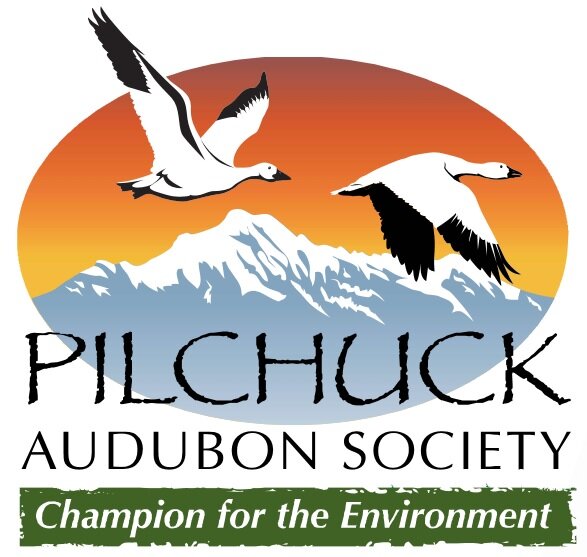Weekend Bird Walk to Camano Island, Barnum Point
March 7, 2020
By Jonathan Blubaugh
Photo: American Robin, Brian Zinke
Pilchuck Audubon Society and the North Sound Birders’ Meetup visited Island County’s newest park development: Barnum Point County Park. Until recently it was known as Barnum Point Preserve. Details may be found here: https://www.liveineverett.com/blog//worth-leaving-town-for-barnum-point-county-park. PAS member, Lisa Weber, sighted the Island County announcement and suggested the outing. I conferred with PAS Weekend Bird Walk Trip Leader, Doug Resnick, and he told me I should make it so. I love taking requests.
Attendance was down due to the viral attack. If it had been even a week later, it probably would have been cancelled in hindsight. Still we had ten people with at least three cancellations. As a precaution most of us caravaned rather than car-pooling. We used sensible precautions. Everybody was in good heath and goods spirits, whilst a bit somber due to the outside circumstances.
We began at a newly built parking lot that has new graveled trails leading away. At the parking lot we met a participant who lives on Camano Island and wanted to meet us at the site. She turned out to be an invaluable guide because not only does she live nearby, her group of volunteers had put in countless hours to bring the park to the public with its numerous improvements. Many thanks to Joan!
I had been to the site once, years before on a dead end road at what is now the south end of the park. We just drove to the end of the road on the eastern shore of the island, looked for birds, and turned around and left. This time we went to the new parking lot uphill from there which is accessible from Sunrise Bl. on the island. She suggested our course to explore the park. We readily agreed. At the parking lot Joan showed us that we were at a holly tree orchard. There were at least three varieties of large holly trees in a fairly large former nursery. It was full of robins enjoying the huge crop of holly berries. She told us the park and volunteers had scheduled the orchard for termination. I said I hoped they wouldn’t take them all out. The hollies were providing prodigious food and shelter for plenty of robins and other fruit loving birds. We lingered at the edge of the parking lot beside the holly grove because, as usual, there was real good birding at the parking lot. It kind of makes sense: when you first arrive at a new site, you start hearing interesting things as soon as you get out of the car. There is great new pedagogical signage at the parking lot and at a few appropriate places on the trails like overlooks. The path past the holly nursery took us down to a small pond with a couple of Mallards on it. It was here that I noticed an Anna’s Hummingbird going straight up as if on an elevator whilst looking straight down as could be seen by his lowered bill. I gathered all the people and asked for silence. I think nearly all of us then saw the spectacular diving display and heard the loud “ting” he makes with his tail at the perigee of his dive. My reward is the tremendous vicarious thrill when the guests get to see and hear such an amazing miracle of nature! No wonder everybody feeds the little daredevils. As we doubled back to the parking area, we stopped to see a few small mixed groups of passerines (which are sometimes referred to as chicklets).
Next Joan led us down a loop trail to the seashore. At the bluff we had sweeping views to the east from Warm Beach on the north to Hat Island, the Tulalip reservation, and the southwest shore of the island. There we found a few seabirds who made viewing a bit challenging because they instated on repeatedly diving out of sight. Another extremely interesting behavior we witnessed was the synchronized diving of the Surf Scoters, which I had never seen before. I estimated there were in the range of 150 scoters in two groups. The nearest raft of scoters, at least a hundred birds, were nearly in a line. When one dove, within seconds all the rest did too, except one straggler who stayed on the surface. We watched this ongoing foraging cycle repeat several times. We don’t know what they were after, but it’s very easy to suggest cooperative hunting just like packs of Harris Hawks.
Here’s a list of most of the birds we saw: a couple of Mallards, the approximately 150 Surf Scoters, three Buffleheads, three Barrow’s Goldeneyes, two Anna’s Hummingbirds, fourteen Glaucous-winged Gulls, a hybrid “Olympic” gull, two Double-crested Cormorants, a Red-tailed Hawk, a red-shafted Northern Flicker, three Steller’s Jays, a crow, two Black-capped Chickadees, a Ruby-crowned Kinglet, a couple of Pacific Wrens, a couple of Bewick’s Wrens, ten American Robins, a couple of House Finches, two Dark-eyed Juncos, a couple of Song Sparrows, and a Spotted Towhee. We also heard a Golden-crowned Kinglet, a Red-breasted Nuthatch, a couple of Brown Creepers, and a couple of Red-winged Blackbirds. All were uploaded to the Cornell Lab of Ornithology via the eBird mobile application.
I will not plan any further Weekend Bird Walks until we can be reasonably certain that the danger of disease transmission has passed, and it is permissible.

